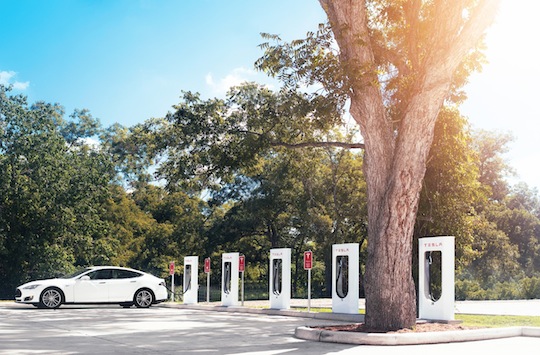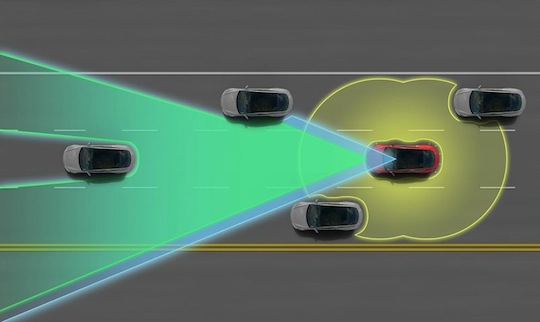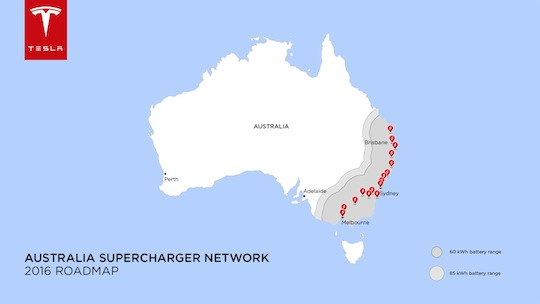Leading the charge: Inside Tesla’s quest to put Australia on the grid
Share
Head of marketing for Tesla Motors Australia takes us through the brand’s vision for this market as the vertically-integrated automative company leads the charge towards an all-electric future.
As one might expect in a luxury segment, the experience of owning a Tesla is a key focus for the brand.
In Victoria and New South Wales a Model S will cost you just over $120,000 – slight cheaper in the ACT as there’s no stamp duty. It’s worth noting that price is adjusted on a quarterly basis based on the exchange rate with the US dollar, so (hopefully) that price can’t go much higher.
Charging infrastructure in and between capital cities has been first on the map since the company officially delivered its first vehicle in Australia in December 2014. The Sydney to Melbourne route is now close to being completely covered by Tesla Supercharger stations, all of which are free of charge.
With Brisbane up next, the company is slowly but surely overcoming the nagging issue of ‘range anxiety’ for its main customer bases across the country. (Interestingly, though perhaps not surprisingly, Tesla argues that range anxiety is actually a symptom of owning a combustion-engine automobile rather than an electric vehicle.)
In Melbourne and Sydney, owners can pop into the Tesla locations and access the 24-7 lounge while their car charges outside.
Heath Walker, marketing and communications manager for Tesla Motors Australia, chats with Marketing about how the brand is approaching the Australian market through events, retail and owner experience.
M: Tesla famously doesn’t do any paid advertising – how are you going to market?
HW: We don’t do any paid advertising or paid sponsorship and there are probably two reasons.
One, we want to invest the money back in to the infrastructure to give our owners what they need in the short term, which is charging infrastructure for long business trips.
Rather than waiting for the chicken or the egg like most other companies that are producing electric cars, we are going out there and doing both at the same time.
The other reason is that it’s very difficult to explain what a Model S is and does in 30 seconds, so at the moment we would need some quite unique marketing and our best marketers are our owners. For them, or anyone that hops in our vehicle, to share their experiences, is the best way.
We do direct marketing, [such as] email campaigns, and also events to just get people in the cars to see what they are all about, because they are so different.
M: What are the main consumer segments Tesla is targeting in Australia?
HW: We attract three different types of people.
The biggest attraction to begin with has been performance, because a lot of our messaging has been to break the idea that electric vehicles are like glorified golf buggies. They’re not at all – they actually get instant torque. It’s a bit like turning on a blender: you get power instantly. Now with the P90D our car goes zero to 100 in three seconds – that’s supercar performance. So we are getting performance enthusiasts through the door.
The second type of person we are getting is tech early adopters who love the technology and the car and maybe haven’t been a car person previously – but this is a car that’s becoming more tech than car. We think of ourselves as a tech company first and an auto company second.
The third is those that see the environmental benefit.
I think those work in harmony with each other, with any one person that walks in they come in and see a performance vehicle with the benefit that they’re not going to be hurting the environment while planting their foot on that pedal.
The environmental person that comes in purely wanting an EV and has been cross-shopping EVs but loves the idea of owning a Model S also loves the fact that they get performance out of it.
They don’t work in isolation but there’s a primary driver in each of those three areas.
M: Telsa is participating in the Future Assembly event, an emerging technology event, what are the other kind of events do you do and do they all map around those three customer segments?
HW: That event probably hits the tech audience first and foremost. We look at broad and then niche in terms of our events.
The broad ones are retail, which means setting up pop-up locations where we might usually look to put a store and trial the market, such as in Chadstone currently.
As you see future roll-outs, you’ll see more retail based set-ups for us, so you’ll see like Apple-esque in regards to the store frontage, inside a retail store or stand alone one.
We’ll have one in Sydney CBD before the end of the year and we’ll probably look at some future ones in Melbourne and Sydney in shopping centres.
Then we look at pop-ups in the meantime because they are really easy to do. You can put one car on display, put a person next to the car, theme it up like Tesla and it’s still in the key location. Certainly in these formative years for Tesla it’s a great opportunity to be out in the open, because if someone walked pass a shopfront and saw Tesla they wouldn’t necessarily go in because they don’t know what Tesla is, so it’s a really good way of educating the market.
That’s mass, and then we look at private company events that we host either here or in our Sydney store, such as for big businesses that have key executives that want to show their staff a different looking company like Tesla, because we are quite unique that we own the full vertical, we are doing things a little differently to the traditional order but also have a product that’s quite fun to look at and share. I often given a presentation of those events and we do test drives with their employees.
We also get to expos, whether it be energy exhibitions, storage exhibitions or sometimes car expos, although there’s not many in Australia these days. We do a few car club events just because a lot of the guys that collect cars are in that performance bracket.
We also run specific test-drive events that are themed Tesla. So we run our ‘billion miles’ event which was to celebrate our fleet globally reaching one billion zero-emission miles.
In the near future we’ll be looking at running a test-drive event to showcase our 7.0 software with autopilot so we can take people out on the freeway and actually show the car and how it uses the autopilot features with the auto-steering, the auto-lane-change and those features which is very cool.
M: How are you addressing the issue of range anxiety, that there’s not a network of service stations everywhere?
HW: It’s a great question, and it’s an education piece really, because it’s a matter of changing the mindset.
Range anxiety hasn’t come about because of electric vehicles. The thing that’s caused range anxiety is actually internal combustion engines because we all sit there and wait for the light to come on to tell us that we need petrol and then we start to panic and look for a petrol station.
The reality of our new electric vehicle is that you plug in when you get home, just like you do your mobile phone, and you wake up with the equivalent of a full tank of petrol every morning.
I don’t know about you, but the last time I woke up and went to the petrol station first thing in the morning, I certainly didn’t need to go to a petrol station before I came home that night. That’s what it’s like living with an electric vehicle. 90 to 95% of your charging is done at home and the additional five to 10% is done as a means of convenience or free charging.

We put in ‘destination charging’ at hotels, shopping centres, resorts and private parking so if you go and park in the city and work all day you can charge for free at a Secure Parking location.
The other major point is for the long distance traveller – that’s probably been the biggest hurdle for electric vehicles – but our Superchargers are the fastest chargers on Earth and they charge half full in 20 minutes or a full charge in just on an hour, and we pay for them.
At the moment we’ve got them based at Euroa, Wodonga, Goulburn, Sydney and Melbourne.
We’ll open Gundagai in the next month as well, which means that people will be able to travel from Melbourne to Sydney, Sydney to Melbourne and to Canberra and not pay a cent along the journey.
We think that will re-engage people into the road trip mentality.
Not only are they hopping in a car that’s great to drive, it’s even better on long distance now that we’ve got the autopilot feature. It launched in Australia last month and it’s super cool technology. Essentially when you hop on the freeway you go to the middle or right-hand lane, put on adaptive cruise control so that reads the car in front and speeds up and down accordingly. You double click on the stalk and then the car will start steering for you within the lane, using multiple sensors: sonar senses on the outside, radar on the front of the vehicle, the camera, and all these things are reading things such as lines, the car in front, even the traffic signs like speed sign and tell you if you are going over.

It also can change lanes as well. If you put your indicator on it will sense around the vehicle and know when it’s clear to move across a lane.
The ability to charge for free along the way certainly helps with the revive and survive message as well. Every 200 to 250 kilometres you stop off for 20 minutes, grab a coffee, something to eat, and then if you do that every time you only need to charge half full because the rapid charge really occurs in that first 20 minutes.
M: How many cars are in Australia at the moment?
HW: We don’t share regional numbers but we have sold more than 80,000 globally.
What I can share is the reaction in Australia has been much more positive than probably what was first predicted. The market’s been extremely positive towards the vehicle despite it being quite an expensive vehicle.
I think people take in to account the cost of ownership. There’s a portion of the fuel – a fraction of the cost – and with servicing, although we haven’t announced pricing yet, we’ll be cheaper than all other luxury brands in the market.
We put a resale value guarantee on the vehicle as well, guaranteeing after three years what the price will be on the car, so that gives consumer confidence.
Then and then less bake wear and tear because of the regenerative braking [kinetic energy generated by using the brakes helps charge the battery].
There is a saving there so I think people take that in to account.
M: What will we see next in terms of developing this market?
We are just about to start test drives in Brisbane which we’ll be running that out of a hotel in the short term. Then we’ll look at having a store out there in the not too distant future. Sydney will have a second store before the end of the year as well.
The Gundagai Supercharger will complete the Sydney-Melbourne route and then we’ll look at going north to Brisbane with the Supercharger network thereafter.

We are working with councils, local governments, whoever is interested essentially. If they have got interest in having a Supercharger then we’ll work with them.
Our focus is to join the major cities from our cost and development point of view because at the moment we are paying for these things. So we need to make sure we work where our population is and where our owner base is and that’s Melbourne and Sydney. It will be Brisbane based on opening a store there so if we can connect those three then we’ll look to go probably west thereafter.
M: I imagine petrol stations aren’t on your list of partners.
HW: Yeah, we try and keep people away from petrol stations, although they might still be in a similar location. We don’t want people standing next to the smelly petrol bowsers while they are filling up with electricity, it doesn’t make sense for the experience.
What we try to do is target amenities, somewhere that’s great to have a bite to eat or stop to go to the toilet.
M: There’s a lot of territory out west.
HW: Exactly, there’s a big, big tranche, but if we can get to Adelaide and then Perth. What you would do in the short term is look at locations that people drive to, whether it’s down to Esperance or up towards the north beaches of Perth, and find locations along there.
In the interim, destination charging certainly helps with that because if you can drive 500 kilometres and then stop at a hotel or whatever and charge like you would be at home you’ve got no issue.















